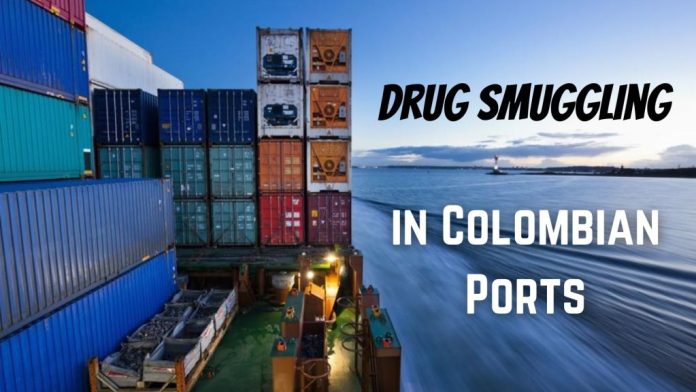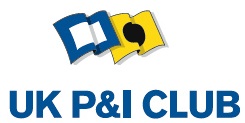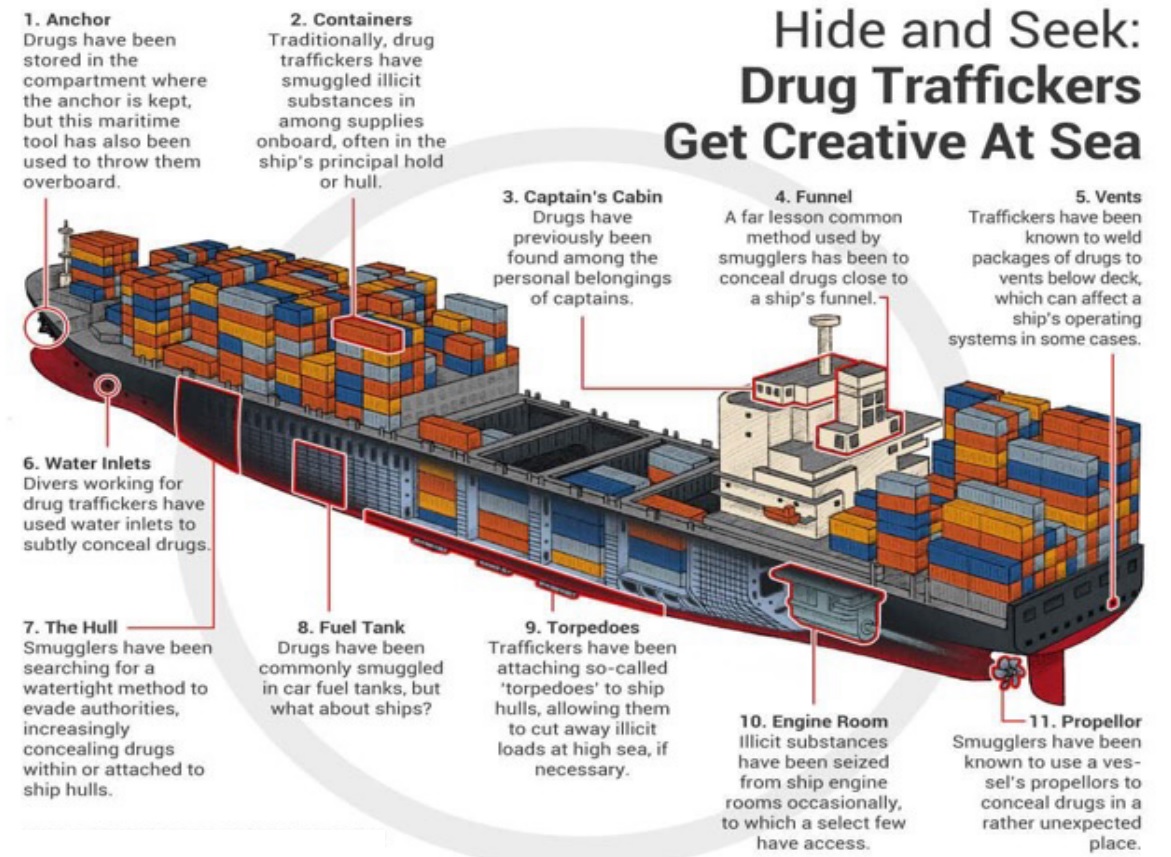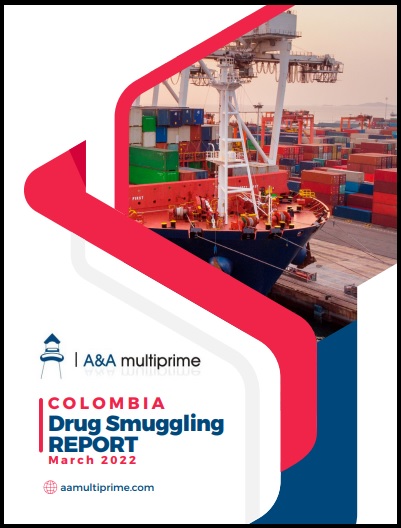
(www.MaritimeCyprus.com) Colombia currently accounts two thirds of the global area under coca bush cultivation and cocaine production. According to the United States department of State Bureau of International Narcotics and Law Enforcement Affairs, it is estimated that Colombia´s potential pure cocaine production increased from 918 metric tons in 2019, to 1,010 metric tons in 2020, which ratifies its undesirable position as the greatest cocaine producer in the world.
The United Nation’s Office on Drug and Crime (UNODC) established that the majority of the cocaine trade around the world is done by sea transport, therefore, this issue tends to become more and more problematic for shipowners and operators, especially when departing from a Colombian port considering that in 2021, the Colombian Navy broke its historical record of drug seizures with 403 tons of illicit substances confiscated.
Most common strategies/methods currently used by drug traffickers.
Colombian drug traffickers develop every day new complex trafficking patterns to use commercial vessels and their crews to transit illicit substances, especially cocaine, worldwide.
Even though Colombian shipping terminals comply with ISPS standards and the Navy and local authorities have implemented several controls to avoid and prevent drug smuggling, drug traffickers have developed creative ways to hide illegal drugs inside and outside the vessels calling at Colombian Ports.
- Introducing bags filled with drugs in the sea chests and/or attaching them to the vessel's hull, rudders, anchors, propeller, vents, or water inlets; using divers while the vessel is berthed or at anchorage.
- Hiding relatively small amounts of drugs in certain remote locations onboard (e.g. cabins, funnels, decks, store room or engine room) with collaboration of stevedores or even crew members. In some cases, visitors (with or without collaboration of the crew) board the vessel and quickly hide these packages in certain remote locations.
- Placing illegal substances within sealed containers before loading. One of the most common methods currently used by drug traffickers all around the world is to break into containers and hide drugs within the cargo, replacing then the security seals (usually this method involves certain level of collaboration from the terminal operators and/or the cargo agents). Most targeted containers are reefers.
- Burying packages with drugs within bulk cargoes. This method allows high quantities of illegal substances to be moved at any time, usually within the stow.
Guidelines for ships when trading in Colombia:
A. Measures before entry
- Advise the master and crew of the increased probability of drug smuggling on vessels calling at any Colombian port, emphasising the need for extra vigilance while at anchor or alongside.
- Crew going onshore should be informed that it is common practice in Colombia for drug traffickers to befriend them in order to achieve their cooperation.
- Prior to the vessel's arrival, the port agent must provide the master with the relevant updated data related to the relevant Colombian port.
- The ship should keep accurate records of all activities observed and the actions taken by local authorities, stevedores, and other shore-based personnel and crew before entry into port, during the stay, and immediately after departure.
B. While in port or at anchor
- Prior to sailing, an underwater inspection could be undertaken by a reliable private diving company in the presence of the P&I correspondent. Please note that such an inspection is not possible at Barranquilla due to the muddy water conditions.
- Although Buenaventura's terminals comply with ISPS standards, it is advisable to provide additional, private security on board.
- Guards may be arranged to patrol around the vessel in launches 24 hours a day. The guards should be instructed to keep a close eye on small craft and fishing boats operating in the vicinity of the vessel, on unidentified divers, and on air bubbles rising to the surface, and to monitor the vessel's stern area very carefully to ensure that no one gains access to the rudder trunk. Please note, however, that these measures can be fairly costly.
- Documentary evidence of the security measures taken by the vessel when visiting Colombian ports should be maintained. Permanent watchmen should be present in areas where stevedores or repair technicians are working on board the ship. Any suspicious activities conducted onboard by third parties should be reported to the master.
- Watchmen should be alert to any packages being brought onto the vessel. Each should be thoroughly checked prior to being permitted on board.
- A strict watch should be maintained at the gangway or the accommodation ladder, and access permitted only persons with a legitimate reason for coming on board.
- The crew should perform regular shipboard inspections throughout the duration of the port call.
- During hours of darkness all areas should be well lit in order to facilitate visual monitoring of activities.
- When possible, place additional lighting over the side to illuminate the surrounding water and the quayside at night. The use of a searchlight during the hours of darkness should be considered.
- When seals for compartments, lockers, containers etc. are discovered to be broken or missing, an investigation should be conducted. If nothing is found, the seals should be replaced by the crew.
- A record should be made in the logbook, together with a note of the outcome of the investigation and search. The relevant seal numbers should be inserted.
- If the master suspects a drug smuggling attempt on board the ship, he or she should immediately report it to the local authorities and the P&I correspondent.
- So far as possible, instruct the ship's crew to remain on board throughout the vessel's stay in port, and not to go ashore unless absolutely necessary.
C. Actions to be taken if drugs are found onboard
- Immediately notify your P&I, the local P&I correspondent, and the shipowner or manager.
- It is very important that the master shows a high degree of co-operation with local authorities. This will result in a positive attitude on the part of the authorities, thereby avoiding unnecessary and costly delays.
- Immediately advise the police at the port. This can be done directly by the master, or through the vessel's agents, and will mitigate the risk of the master and the crew becoming part of the criminal investigation.
- Photograph or make a video of the area of the ship where the drugs are found, but leave the site untouched, and seal it off to prevent unauthorized access.
- If drugs are found on board, the crew members and the master may be temporarily placed in custody. They will be part of a preliminary investigation. The vessel will be detained at port for further investigation. Sometimes, when drugs are found within containers, the containers may be confiscated as evidence.
D. Additional precautions and recommendations
- If possible in Colombian ports, vessels should avoid bunkering, ship's chandler services, and taking on provisions.
- A common place for hiding drugs is inside the rudder compartment. It is therefore recommended, for vessels calling repeatedly at Colombian ports, that a grating or other suitable barrier is fitted to prevent access.
- Underwater inspections at Barranquilla are not frequent because the waters are very murky and silted, making the visibility very low. Additionally the river current is fairly strong, and may seriously compromise the safety of divers. For these reasons it is extremely difficult for smugglers to work underwater and attach drugs to the vessel's hull.
- If, however, shipowners choose to perform an underwater survey at Barranquilla, it must be made outside the river waters in open sea, usually at a location called Caño Agua Dulce. These underwater surveys require the approval of the harbour master's office.
- It is mandatory for the vessel to maintain a pilot on board at all times during the survey. For this reason, the cost for these surveys can be very high.
- If an underwater survey is carried out, particular attention should be paid to the bilge keels, sea chests, tunnel thruster gratings, sacrificial anodes, and the rudder trunk. Our local correspondents can assist with suggesting reliable diving/underwater inspection companies.
- It is very important to determine the rotation of the vessel. For example, if the vessel is calling at Acajutla and the north central American ports first, the risk of drug smuggling is minimal. The highest risk rotation is from Colombia, Panama, or Costa Rica, to North or Central American ports.
For even more information and onboard Preventive Measures, download the report below Drug Smuggling REPORT:
Source: UK P&I Club

Read also:
How US$1B worth of coke was hidden onboard containership MSC Gayane.
Risk Focus: Drug smuggling in commercial shipping.
Maritime risk Focus: Drug Trafficking on Ships.















